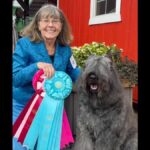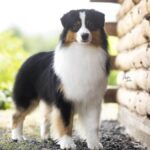Interview with Non-Sporting Group Judge Darryl Vice
Where do I live? How many years in dogs? How many years as a judge?
Darryl Vice: I live in Palm Springs, California, but grew up in upstate New York. I have been in dogs since the late Seventies. I have been judging since 1993 and judge four Groups. I have judged the Non-Sporting Group since 2002.
What is my original breed? What is/was my kennel name?
Darryl Vice: My original breeds were the Miniature Pinscher and Brussels Griffon; however, I always had a Working Breed on the property. I bred under the kennel name of Rrydal, and I bred many champions in both of my breeds.
What are some of the qualities I most admire in the Non-Sporting Breeds?
Darryl Vice: I really enjoy judging the Non-Sporting Group because I think it is one of the most diverse Groups we have. Whenever you put Poodles and Bulldogs in the same Group it opens up for diversity. I enjoy the large differences in that Group, and looking for the most typical dog for its breed.
Can I speak to the overall quality of the more popular Non-Sporting Breeds/Varieties; Bulldog, French Bulldog, and Standard & Miniature Poodles?
Darryl Vice: I do feel there are overall good qualities in the more popular breeds, especially in certain parts of the country. When there are more dogs bred in a certain breed, such as French Bulldogs and Poodles, you tend to have more quality in your ring. However, there are many breeds in the Non-Sporting Group that do not have large entries. I feel this is because these breeds are not bred as much.
What about the overall quality of the more “vulnerable” breeds; Coton de Tulear, Finnish Spitz, Löwchen?
Darryl Vice: The Coton de Tulear, Finnish Spitz, etc., with these breeds and other small-entry breeds, we do not see as many. Therefore, usually when we do have them they are of just average quality. Don’t get me wrong, there are some very nice ones out there with great quality, just not in abundance. I do feel when they changed the standard of the Finnish Spitz to less leggy, they changed the whole look the dog. The breed used to be longer in leg than elbow to withers. That was for a very good reason; to reach in and out of tall snow drifts while hunting. They also moved a little differently, then from now, with the 50/50 leg. The Finnish Spitz is a breed that is not bred as much as, let’s say, the Poodle, Bulldog, Dalmatian, and Chinese Shar-Pei.
Would I have any advice to impart to newer judges of the Non-Sporting Breeds who come from other Groups?
I think new judges coming into this Group really have to dissect the breed standards and the reason for each breed’s existence. This is true in any Group, but in this Group there really aren’t any similarities except for the two Poodles. Just don’t go into the Group because it’s a small Group; you won’t be doing the breeders any favors.
Darryl Vice: Back to diversity; these are all completely different breeds. This is what makes the Group so different and enjoyable to judge. I think new judges coming into this Group really have to dissect the breed standards and the reason for each breed’s existence. This is true in any Group, but in this Group there really aren’t any similarities except for the two Poodles. Just don’t go into the Group because it’s a small Group; you won’t be doing the breeders any favors.
In my opinion, how do today’s exhibits compare with the Non-Sporting Dogs of the past?
Darryl Vice: As far as dogs in the past, there have always been great dogs years back, and new dogs coming along are just as great or even better. I think breeding has improved temperaments through the years in many of the breeds in this Group. A lot of them had behavior and temperament issues but not so much anymore. Some would say grooming has come a long way but, for the better or worse, this depends on who you talk to.
Why do I think Non-Sporting Dogs can become such outstanding Show Dogs?
Darryl Vice: A great Non-Sporting Dog can compete for BIS along with any of the other Group Dogs—and they have and will continue to do so.
If I could share my life with only one Non-Sporting Breed, which would it be and why?
Darryl Vice: One of the breeds that I have always wanted was a male Standard Poodle. I think they are very smart, clean, sweet, and maybe a little arrogant. I used to travel with someone who had them and I really enjoyed them… maybe, someday.










